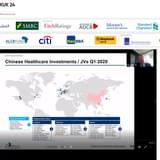Although it remains to be seen what TPP’s future will be under Trump, or whether the President-elect pulls the US out or replaces the wide-reaching trade agreement with a revised deal, it appears that TPP in its current form is finished.
The demise of TPP would likely have multi-faceted political ramifications for those nations involved in the deal, as well as other large players in the Asia-Pacific region.
The US itself stands to lose out substantially form leaving TPP. By withdrawing from the deal, the country would face negative implications in the sense that it would be less engaged in global trade.
“It is a huge disadvantage for the US not to be involved in TPP because it will not have the opportunity to influence the global trade architecture for the 21st Century,” said Daniel Wagner, Managing Director, Risk Solutions at Risk Cooperative.
Despite a potential US withdrawal, Wagner added that it was clear that many countries still wanted to have and participate in a multilateral trade framework.
Although the collapse of TPP will not affect growth prospects of the EMs, such nations will have to forgo the benefits that the deal would have provided them.
Optimistic estimates have put the potential boost TPP would have provided at 15% of GDP over 10-years. There were, however, other factors that made the deal appealing to those involved, particularly EMs.
“In the EM world, TPP was liked because it went beyond the normal trade agreements that are usually seen between countries. Tariff levels across the world are now very low, so there is little benefit to cutting them further, but TPP did try to cut down non-tariff barriers such as government procurement, and was stricter on intellectual property rights, which are not covered in current trade agreements,” said Gareth Leather, Senior Asia Economist, Capital Economics.
However, the desire to maintain a multilateral framework has complicated the landscape for those involved in the proposed agreement. Some are planning to continue with TPP minus the US, whilst others, such as Malaysia and Vietnam – which were set to be the largest beneficiaries of the deal – will not go ahead without the US.
A report by Capital Economics stated that although the 11 remaining countries involved in the TPP agreement may go ahead with the deal regardless of the US’s withdrawal, it was somewhat meaningless without the US, as access to the country’s market was the main attraction of TPP for ASEAN economies.
The potential collapse of the trade deal means that regional EMs will either double down on bilateral trade arrangements or will participate in other multilateral trade frameworks.
Jose Brito, Chief Economist at Millennium BCP noted that even excluding China, the sizeable demographics of the APAC region meant that there was still huge potential to create a free trade zone – which could have positive implications for the region’s economies.
“Because countries in this region tend to have around the same level of development, and are more or less specialised in the same areas, in a free trade area they will have to compete, and thus innovate. In the long-term this would provide a boost to their economies because they will have to diversify.”
Furthermore, the region’s capital markets could grow further through strengthened regional trade ties.
“Asian nations will have to hold each other’s currencies if they are going to trade and invest more, which could lead to further development of the regional capital markets.”
Ultimately, it appears that a new framework would likely be formed following the demise of TPP, only without US involvement. This provides a great opportunity for China, which would likely be the architect of any new deal. Uncertainty around TPP has provided the world’s second largest economy with the chance to push through its own version, the Regional Comprehensive Economic Partnership, or RCEP, which excludes the US, just as TPP excluded China.
The deal could gain traction in the region through its wider inclusiveness and the growth potential of the Chinese economy. According to the Capital Economics report, Asia could receive a larger boost through China and the RCEP than through the US and the TPP, as China is already a larger export market than the US for many Asian economies, and China’s growth prospects are better than those of the US.
The report continued that the main beneficiaries from the failure of TPP would be countries excluded under the deal such as the Philippines, Korea and Thailand (not to mention China itself). The former three nations would have seen their growth prospects suffer if TPP stimulated regional supply chains that did not include these countries.
However, despite the attractiveness of Chinese growth and RCEP’s wider inclusiveness, the deal is unlikely to be as favourable to ASEAN nations as TPP.
“China’s deal is less ambitious, and only focusses on cutting tariff barriers, not non-tariff barriers. Within Asia, tariff barriers are already low, so the economic benefits are not that significant,” Leather noted.
The 2010 China-ASEAN free trade agreement saw the average tariff rate on ASEAN exports to China fall from 10% to 0.1%.
Nevertheless, with few alternatives and no other multilateral frameworks in the works, the RCEP will likely be adopted in lieu of TPP.
“China has influence in so many different areas politically and economically, it is outmanoeuvring the West. America’s Asia-pivot has not benefitted the US as anticipated, with Malaysia and the Philippines now running into the arms of China,” Wagner stated.
Leather also noted that RCEP was more about geopolitics than economics. “With the demise of TPP and the withdrawal of the US from Asia, China has an opportunity to write the rules.”
Although Trump may be somewhat of a latecomer to America’s waning influence in the APAC region, he will likely hasten the weakening of the US’s regional power by repealing TPP.
“Trump will probably succeed in pulling the US out of TPP, as he will have the support of Congress. This is too important to too much of the core constituency of the Republican Party to walk away from. This is one of the policy matters he will prevail on,” Wagner noted.
However, it appears that TPP was unlikely to ever make it far even before the US election. “The chances of TPP happening in its current form were relatively slim, particularly because not only Donald Trump, but also Hillary Clinton was against it,” Leather noted.
This has meant that the economic forecasts for the countries involved remains little changed: Vietnam still has relatively good growth prospects and is benefitting from rising labour costs in China, which is seeing low end manufacturing migrate to the country.
“Singapore was never likely to benefit too much from TPP anyway, and Malaysia is embroiled in its own corruption scandal and low oil prices, so there are more immediate concerns for the country in that respect,” Leather continued.
Regardless, the potential demise of TPP points to a larger threat on both the political and economic fronts. “The greatest risk going forward is the rise of economic nationalism,” Wagner concluded.









